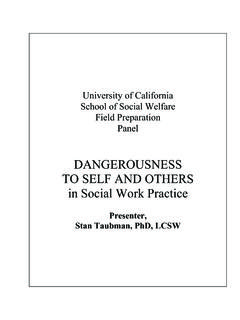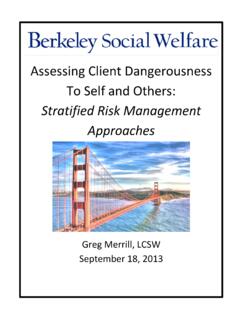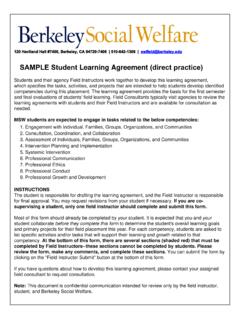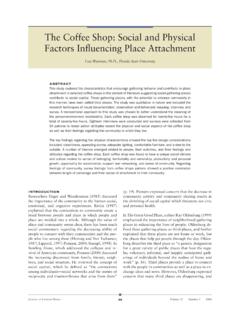Transcription of Assessing Client Dangerousness To Self and Others ...
1 Adam Johnson, a 28-year-old European American who served in the Marines Special Forces in Iraq Assessing Client Dangerousness To self and Others : Stratified Risk Management Approaches Greg Merrill, LCSW. September 18, 2013. Relevant Ethical Standards from NASW Code of Ethics Commitment to clients Social workers' primary responsibility is to promote the well-being of clients . In general, clients ' interests are primary. However, social workers' responsibility to the larger society or specific legal obligations may on limited occasions supersede the loyalty owed clients , and clients should so be advised. self -Determination Social workers respect and promote the right of clients to self -determination and assist clients in their efforts to identify and clarify their goals. Social workers may limit clients ' rights to self -determination when, in the social workers' professional judgment, clients ' actions or potential actions pose a serious, foreseeable, and imminent risk to themselves or Others .
2 Privacy and Confidentiality Social workers should protect the confidentiality of all information obtained in the course of professional service, except for compelling professional reasons. The general expectation that social workers will keep information confidential does not apply when disclosure is necessary to prevent serious, foreseeable, and imminent harm to a Client or other identifiable person. In all instances, social workers should disclose the least amount of confidential information necessary to achieve the desired purpose; only information that is directly relevant to the purpose for which the disclosure is made should be revealed. Relevant California Laws Related to Lawful Breach of Confidentiality Welfare and Institutions Code 5150. When any person, as a result of mental disorder, is a danger to Others , or to himself, or herself, or gravely disabled1, a peace officer, member of the attending staff .. of an evaluation facility designated by the county, designated members of a mobile crisis team.
3 Or other professional person designated by the county may, upon probable cause, take, or cause to be taken, the person into custody and place him or her in a facility designated by the county and approved by the State Department of Mental Health as a facility for 72-hour treatment and evaluation. Civil Code .. If the patient has communicated ..a serious threat of physical violence against a reasonably identifiable victim or victims ..a psychotherapist discharges his or her duty to protect by making reasonable efforts to communicate the threat to the intended victim or victims and to a law enforcement agency .. 1. Grave disability usually refers to the condition of a Client who is so impaired by a mental disorder that they are unable to meet their basic needs for food, clothing, or shelter and/or who has been assessed by a medical professional to be mentally incompetent due to mental disorder. Relevant Case Law for Breaching Confidentiality Tara off v.
4 Regents of UC (1974, 1976). The Supreme Court of California held that mental health professionals have a duty to protect individuals who are being threatened with bodily harm by a patient. The original 1974 decision mandated warning the threatened individual, but a 1976 rehearing of the case by the California Supreme Court called for a "duty to protect" the intended victim. The professional may discharge the duty in several ways, including notifying police, warning the intended victim, and/or taking other reasonable steps to protect the threatened individual. Ewing v. Goldstein (2004). Upheld in appellate court, Ewing v. Goldstein is a landmark court case that extended California mental health professional's duty to protect identifiable victims of potentially violent to include acting upon communications from third parties, particularly family members and particularly if that information leads the therapist to believe or predict that the patient poses a serious risk of grave bodily injury to another.
5 Key Suicide Risk Assessment Questions Suggested Clinician Style: Friendly (compassionate, warm, concerned, supportive, Client -centered), Frank (direct, candid, unafraid to ask or talk about risks plainly), and Firm (asking in a confident tone and insisting that this discussion is essential, imperative, and necessary). These help establish therapeutic trust, clear expectations, and relational honesty. 1. Suicidal Ideation (Normalize): When someone feels as upset as you do, they may have thoughts that life isn't worth living. What thoughts have you had like this? 2. Suicidal Planning (Means). If you decided to try to end your life, how would you do it? Tell me about the plans you've made. 3. Access to Means You mentioned that if you were to hurt yourself, you'd probably do it by (describe method). How easy would it be for you to do this? 4. Protective Factors (Normalize): People often have very mixed feelings about harming themselves. What are some reasons that would stop you or prevent you from trying to hurt yourself?
6 What is it that most holds you back from actually doing this? 5. Past Experiences What have been your past experiences of making attempts to hurt yourself? What other people do you know who have tried to or have ended their own life? 6. Future Expectations What are some of the things happening in your life or likely to happen in your life right now that would either make you more or less likely to want to hurt yourself? How do you think people who know you would react if you killed yourself? What would they say, think, or feel? Key Homicide Risk Assessment Questions Suggested Clinician Style: Friendly (compassionate, warm, concerned, supportive, Client -centered), Frank (direct, candid, unafraid to ask or talk about risks plainly), and Firm (asking in a confident tone and insisting that this discussion is essential, imperative, and necessary). These help establish therapeutic trust, clear expectations, and relational honesty. 7. Homicidal Ideation (Normalize): When someone feels as upset as you do, they may have thoughts about hurting the person who has upset or hurt them.
7 What thoughts have you had like this? 8. Planning (Means). If you decided to try to hurt _____, how would you do it? Tell me about the plans you've made. 9. Access to Means You mentioned that if you were to hurt _____, you'd probably do it by (describe method). How easy would it be for you to do this? 10. Protective Factors (Normalize): People often have very mixed feelings about harming other people. What are some reasons that would stop you or prevent you from trying to hurt _____? What is it that most holds you back from actually doing this? 11. Past Experiences What have been your past experiences related to hurting people who have hurt you? 12. Future Expectations What are some of the things happening in your life or likely to happen in your life right now that would either make you more or less likely to want to hurt_____? How do you think people who know you would react if you actually did this? What would they say, think, or feel? What would be some of the consequences?
8 Stratified Clinical Responses to Risk Risk Intervention Options Level Low Provide Client with support and affirmation Instill hope without invalidating despair Help Client to improve and expand coping related to immediate stressors and environment Help Client to avoid, minimize, or respond differently to immediate stressors Help Client to enlist family, friend, and community supports Provide advocacy to remove stressors or access supports Develop a basic safety plan Discuss possible medication referral and other helpful self - management options Reassess periodically Document Medium In addition to the above, consider: Consultation with or second opinion from experienced clinician Involving the Client 's support system Developing a more specific safety plan and/or contract;. specifically, Client should agree to call identified crisis resources prior to carrying out plan The Client should surrender access to lethal means Encourage structure in the Client 's life including homework and scheduled activities HIGH In addition to the above, consider: Arranging for further crisis assessment by mobile crisis time or psychiatry emergency center with or without patient's knowledge and consent In the instance where Client poses danger to identifiable Others , make reasonable efforts to call, write, or reach them What Usually Happens After 5150 is initiated?
9 Treating clinician provides detailed information about risks and concerns Further Client is further assessed by police or trained crisis expert or service Assessment Client is deemed not to pose an imminent risk to self or Others or be gravely disabled and is released Decision to Hold Client is held for further observation and/or treatment (72 hours). Client may be held for continued, discrete periods of time but either must consent or must be approved by a court officer Renewal of Hold Client may be voluntarily discharged to a less restrictive setting Visit Client and continue to assume primary treatment role Collaborate with inpatient team and patient on safe, effective treatment plan and Clinical Follow-Up discharge back to least restrictive setting VA Safety Plan: Brief Instructions2. Step 1: Recognizing Warning Signs __ Ask How will you know when the safety plan should be used? . __ Ask, What do you experience when you start to think about suicide or feel extremely distressed?
10 __ List warning signs (thoughts, images, thinking processes, mood, and/or behaviors) using the patients' own words. Step 2: Using Internal Coping Strategies __ Ask What can you do, on your own, if you become suicidal again, to help yourself not to act on your thoughts or urges? . __ Ask How likely do you think you would be able to do this step during a time of crisis? . __ If doubt about using coping strategies is expressed, ask What might stand in the way of you thinking of these activities or doing them if you think of them? . __ Use a collaborative, problem solving approach to ensure that potential roadblocks are addressed and/or that alternative coping strategies are identified. Step 3: Social Contacts Who May Distract from the Crisis __ Instruct patients to use Step 3 if Step 2 does not resolve the crisis or lower risk. __ Ask Who or what social settings help you take your mind off your problems at least for a little while? Who helps you feel better when you socialize with them?








